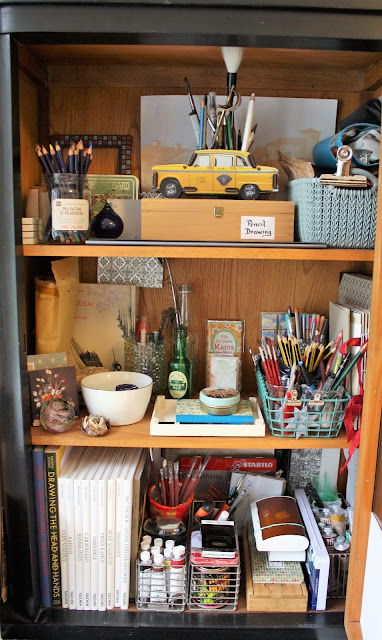Shadow, and the flat light of Autumn.
Sitting in my grey armchair, slightly blinded by the low autumn sun pouring into the livingroom, I can clearly see the details of the facade out of the window and across the street. Long shadows throw the curves of the molded trim into relief while the strength of the sun picks out its detail. It is mid-October and the clean, washed out colors and surfaces of high summer are long gone. Autumn with its warm, golden light and deep shadows is like nature's gift to the painter.
One of the things that new painters often struggle with is creating depth, making their work look three dimensional, not in the way a comic looks 3D but rather in the way that real things have form and volume. While I went into some ways of creating depth in a previous blog post (see How to Create Depth in a Painting ), I would like to take a look at shadow specifically today.
I belong to a facebook group called, 'Acrylic painting for everyone'. In this group painters of all levels can ask technical questions and show their work. Skill-wise most members fall somewhere in the middle and try their best to help with the questions that they can answer. I do my best to answer questions as often as I have the chance. And it is interesting to me that so often the answer to the question is 'shadow'. How can I improve this painting? Why does my picture look flat? How do I add depth? Why does my painting look like a coloring book? Why doesn't my object look heavy? Most of the time the answer is More shadow.
Here are a few things to keep in mind when adding shadow to a painting:
Color:
-A shadow is seldom a single color. It is made up of a complex mixture of colors, often based on the surface upon which it falls. So if it falls on grass or water it won't be grey but rather dark green, or even dark blue or purple. If the object casting the shadow is transparent flecks of light will shine through it creating a colored haze in the shadow itself.Graduation:
- A shadow is not a solid, it fades as it moves away from the object it imitates. This means that the darkest part will be right up under the object. This area is almost black. The point furthest away will be lightest. There are a few exceptions, for example, occasionally the shadows that slice across building is fairly uniform. They are often the result not of a specific object but rather of the sun being blocked by something certain distance off, such as the houses on the other side of the street.Light direction:
- This should be obvious but is occasionally overlooked. A shadow showed where the light comes from, all shadows should reflect where the sun or lamp is shining. If they don't the result will be conflicting shadows. Because this is the case, not every shadow will be exactly parallel to one another, but they will always fall away from the light source.Two Dimensional:
- Living in a three-dimensional world it is probably wise to occasionally be reminded that shadows are absolutely two dimensional, they do not have body or structure. They can be painted with either a lasur or in normal strokes in deeper colors, but they should not include rounded strokes as that will suggest that they themselves have substance.Indication of surface:
- Although the shadow itself is flat the surface upon which it falls may not be. If it falls on gravel the edges may be corrugated. If it falls on grass they will be ragged. A rounded wall will result in a rounded shadow even if the object that threw it is flat, as for example, a roof is.Brightens brights:
- Finally, there is one last aspect which has become clearer and clearer to me recently. The darker the shadow is, the brighter the highlights will appear. So if the colors look dull and lackluster on a painting or photo try playing around with the shadows. Deepening them by about two grades will usually create a much livelier image. This is in fact very little different than what we observe in autumn. The Deep shadows, thrown by the low sun, cause the sunlit details to pop out at us. The result, everything looks nearer and more detailed.Painting shadows can be intimidating because they tend to never be dark enough. Deepening them is often scary. I have frequently worried that I would ruin the picture. But aside from the time that I had the brilliant idea to make all my shadows dark green just to see how it would look, (the answer is seasick), that has never happened. Now I just take a deep breath, grab my brush and go for it, it usually only takes a few seconds to see my picture really improve.
So what about you? Are you a painter? Have you struggled with shadows or depth? Let me know in the comments.
To get posts as soon as they are published click on the subscribe button at the top of the page or Follow by clicking on the follow button.























Comments
Post a Comment